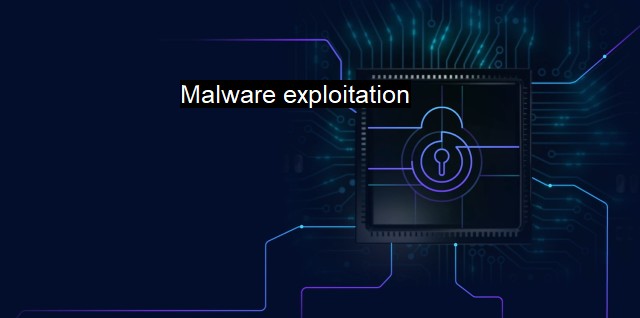What is Malware exploitation?
Malware Exploitation: Understanding the Threat to Cybersecurity
"Malware exploitation" is a term that resonates profoundly in the world of cybersecurity and antivirus. To understand malware exploitation, we need to first define what malware is. Malware, short for malicious software, refers to an application or software created with the intent of causing harm to data, devices, or to a network. They are intrusive and disruptive tools leveraged by cybercriminals to steal sensitive or classified data, hijack computer operations, monitor user activities without their consent, or disrupt digital infrastructure.Malware exploitation, then, is about how cyber attackers use malware to exploit vulnerabilities in a system. These vulnerabilities are usually loopholes or weaknesses present in a system - it could be a faulty software design or user negligence. These give way for an attacker to execute malicious activities, commonly through the internet, with the aim to exploit them for their benefits.
A wide variety of malware exists, including viruses, worms, trojans, spyware, ransomware, adware, and many more. Each has a unique approach to exploitation and causes different types of damage. For instance, spyware is used to gather personal or financial information from a user's system, typically without knowledge or consent. On the other hand, ransomware encrypts valuable data on the victims' system and demands a ransom to release it.
Cybercriminals employ techniques like social engineering or phishing to trick users into executing their malicious payloads. Also, they commonly use malware to exploit system software vulnerabilities, such as outdated or incompatible software, as the entry point. Once they've gained unauthorized access, these cybercriminals can execute various disruptive or damaging actions such as stealing sensitive data, blocking normal operations, controlling the computer remotely, or even launching attacks on other systems.
The manipulation of malware to capitalize on these vulnerabilities is part art and part science. Sophisticated fraction of cybercriminals have the knack of muddling these vulnerabilities, implying their attack vectors, effectively making traditional defenses inefficient. The accelerated growth and complexity of malware, the sheer scale and diversity of targets for infiltration, and the continued rise of zero-day vulnerabilities (security holes that manufacturers are unaware of and hence no patch exists) require next-gen cybersecurity strategies for detection and mitigation.
Security participants react to malware exploitation through the development and implementation of malware protection tools, namely antivirus software. These tools use definition-based detection to check files against a database of known malware signatures. Not limited to these, they also seek proactive techniques, focusing on behavioral-based detection methods. This method analyzes a system or network's behavior pattern to detect inconsistencies, which are a sign of malware presence. Along with containment, it is also pivotal to consider susceptibility analysis to identify a network or system's weakest points and to focus security measures there.
Importantly, such defenses shouldn't be implemented in isolation, but as a part of a broader security strategy. Elements such as continuous education and awareness measure, access controls, network segregation, backup solutions, and prompt patching should be considered.
Malware exploitation is a serious cybersecurity threat with relentless and evolving modes of attacks that capitalize on system vulnerabilities. The efficiency of security losses against malware exploitation is not entirely restful, pointing towards the need of being proactive in security design with integrated systems that can offer better protection. Vigilance and proactive situational awareness remain key to deter exploitation by identifying it quickly and minimizing the aftermath. Assuring cybersecurity is not just a task, but an ongoing process, adapting to evolving threats in the landscape.

Malware exploitation FAQs
What is malware exploitation?
Malware exploitation refers to the use of malicious software (malware) to exploit vulnerabilities in computer systems, applications, and networks. This can result in unauthorized access, stealing of data or resources, or disruption of normal computer operations.What are the common types of malware exploitation attacks?
Some common malware exploitation attacks include malware injection, zero-day exploits, phishing, and social engineering attacks.How can I protect my computer from malware exploitation?
There are several ways to protect your computer from malware exploitation, including regularly updating your operating system and applications, using an antivirus program with real-time scanning, avoiding suspicious emails and attachments, using strong passwords, and being cautious when downloading software from the internet.What should I do if I think my computer has been compromised by malware exploitation?
If you suspect that your computer has been compromised by malware exploitation, it is important to disconnect it from the internet to prevent further damage. You should then run a full scan with your antivirus software and take steps to remove any malicious software that is found. It may also be necessary to reset your passwords and monitor your financial and personal accounts for suspicious activity.| | A | | | B | | | C | | | D | | | E | | | F | | | G | | | H | | | I | | | J | | | K | | | L | | | M | |
| | N | | | O | | | P | | | Q | | | R | | | S | | | T | | | U | | | V | | | W | | | X | | | Y | | | Z | |
| | 1 | | | 2 | | | 3 | | | 4 | | | 7 | | | 8 | | |||||||